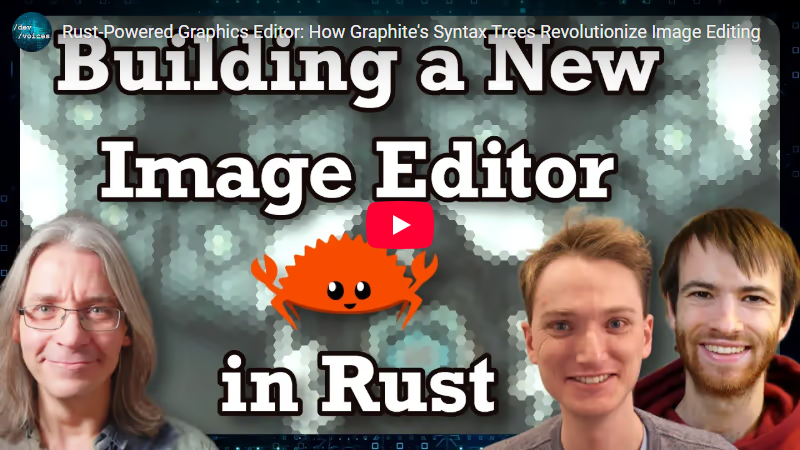Graphite features
The current alpha version of Graphite is a tool for vector art and graphic design. It also supports a limited, experimental raster editing toolset. This tooling is built around a procedural graphics engine, letting artists build complex graphics and animations in its visual scripting language.
In 2025, stay tuned for performance improvements, a native multiplatform desktop app, and the beginnings of a full raster editing tool suite.
Layers & nodes: hybrid editing
Graphite combines the best ideas from multiple categories of digital content creation software to reimagine the workflows of 2D graphics editing. It is influenced by the core editing experience of traditional layer-based raster and vector tools, the nondestructive approaches of VFX compositing programs used by film studios, and the boundless creative possibilities of procedural production tools daily-driven by the 3D industry.
Classic layer-based image editing is easy to understand, employing collapsable folders that help artists stay organized. A variety of interactive viewport tools make it easy to manipulate the layers by drawing directly onto the canvas. On the other hand, node-based editing is essentially artist-friendly programming. It works by describing manipulations as steps in a flowchart, which is vastly more powerful but comes with added complexity.
The hybrid workflow pioneered by Graphite is able to deliver a classic tool-centric, layer-based editing experience built around a procedural, node-based compositor. Users can ignore the node graph, use it exclusively, or switch back and forth with the press of a button while creating content. Interacting with the canvas using tools will manipulate the nodes behind the scenes. And the layer panel and node graph provide two equivalent, interchangeable views of the same document structure.
Raster & vector: sharp at all sizes
Digital 2D art commonly takes two forms. Raster artwork is made out of pixels which means it can look like anything imaginable, but it becomes blurry or pixelated when upscaling to a higher resolution. Vector artwork is made out of curved shapes which is perfect for some art styles but limiting to others. The magic of vector is that its mathematically-described curves can be enlarged to any size and remain crisp.
Other apps commonly focus on just raster or vector, forcing artists to buy and learn separate products for both. Mixing art styles requires shuttling content back and forth between programs. And since picking a raster document resolution is a one-time commitment, artists often choose to start out big, resulting in sluggish editing performance and multi-gigabyte documents.
Graphite reinvents raster rendering so it stays sharp at any scale. Artwork is treated as data, not pixels, and is always redrawn at the current viewing resolution. Zoom the viewport and export images at any size— the document's paint brushes, masks, filters, and effects will always be rendered in full detail.
Marrying vector and raster under one roof enables both art forms to complement each other in one cohesive creative workflow. (Scalable raster compositing is still experimental.)
